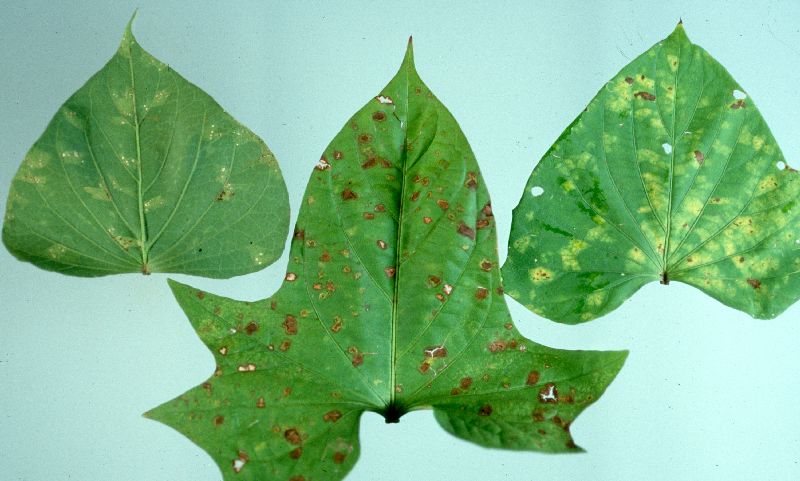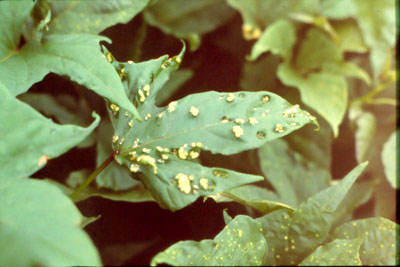|
| Kingdom |
Chromista |
| Phylum |
Oomycota |
| Order |
Peronosporales |
| Family |
Albuginaceae |
White rust is a minor disease of sweetpotato, present only on certain
cultivars.
There are no records about the importance of the disease on yield.
Parts of Asia, Caribbean, Europe, Pacific Islands, South America
and North America. Countries recorded include Australia, Azerbaijan, Cuba, Dominica, Dominican
Republic, France, French West Indies, Guyana, Haiti, India, Italy, Jamaica,
Malta, Morocco, Pakistan, Peru, Puerto Rico, Saint Vincent and the Granadines,
Sudan, Turkmenistan, USA, and Uzbekistan.
The most obvious symptom is the presence of chlorotic or yellowish blotches,
initially roundish to angular where they are limited by veins, on the upper surface of leaves. On the lower surface, small
pustules develop which later open and expose whitish masses of sporangial
pustules. After sporulation, the infected tissue dies, forming
irregular-shaped brown lesions.
In some cultivars or growing conditions, infection induces the development of
galls of
raised, thickened tissue. Galls may
develop on leaves, petioles, stems and flowers. When pustules erupt, the
galls become covered in the white spores.
Diseased plants can also present general distortion, defoliation and flower
abortion. Distortion may occur where galls form on any part of the stem. The
disease may cause twining while twining species may assume an upright habit.
In some very sensitive cultivars, symptoms resembling witches’ broom, with shortening of
internodes and bunchy growth habit, have been observed.
The mycelium is intracellular with
typical knob-like haustoria. The sori are
amphigenous or caulicolous, white or light yellow, prominent, superficial,
measure 0.5-2.0 mm, rounded, often confluent and frequently producing marked
distortion of the host. The sporangiophores
are hyaline, club shaped, unequally curved
at the base and measure 15 x 30 µm. The sporangia
are produced in chains. They are short, cylindrical, with more rounded terminal,
hyaline, and smooth; the membrane with an equatorial thickening, is usually very
pronounced, measuring 14-20 x 12-18 µm. The oosporic sori are separated from
the sporangial caulicolous, rarely on the petioles, measure 1-2 x 5-6 cm or even
more causing marked distortion of the host. The oospores are light yellowish
brown, 25-55 µm in size, and are epispore papillate or with irregular, more or
less curved ridges.
During the growing season, the disease is spread by air borne sporangia
after landing on the plant surface. Germination can be direct such that
the sporangia produce an infecting hypha
which penetrates the plant tissue, develops intercellulary and sends round
haustoria inside the cells. There is indirect germination when the sporangium
liberates biflagellate zoospores that swim in a film of water and invade the
cells.
Oospores overwinter in crop refuse (leaves and stems) in the field and are
responsible for primary infection of sweetpotato plants the following growing
season.
There is no information about the environmental factors that favour white
rust development in sweetpotato. The only factor mentioned was rainfall. In
other Oomycetes, the free water on plant surfaces determines the way in which
the sporangia will germinate. Hence, with direct germination one sporangium is
one infection point but if germination is through indirect germination, each
zoospore is one infection point and every sporangium contains several zoospores.
In the case of A. ipomoeae-panduratae, germination directly or
indirectly occurs optimally at 12-18°C. Infection occurs through stomata during
periods of rain and cool temperatures.
Distinct races of A. ipomoeae-paduratae are found on Ipomoea
batatas and other Ipomoea spp. These races morphologically differ
from each other.
Ipomoea batatas (sweetpotato) is the primary host. Other hosts are
members of the Convolvulus family (morning glory) such as: I. pandurata, I.
pentaphylla, I biloba, I. horsfalliae, I. purpurea, I. reptans (water
spinach), and Calonyction aculeatum. The disease has also been
observed in some members of the family Amaranthaceae such as Amaranthus albus
(white pigweed).
The symptoms in the field are so evident, that no special diagnosis is
needed.
No control methods are mentioned in the literature, apparently because
infections are not serious enough.
In extreme cases copper fungicides can be used, as for other fungi of the
same group.
Clark, C.A., and Moyer, J.M. 1988. Compendium of sweetpotato diseases. The
American Phytopahological Society. APS Press, Minnesota, USA. 74 p.
Holliday, P. 1980. Fungus Diseases of Tropical Crops. Dover Publications Inc.
New York 607 p.
Mukerji, K.J. and
Chrichet, C. 1975. Albugo ipomoeae- panduratae. CMI Descriptions of
Pathogenic Fungi and Bacteria No. 459.
Contributed
by: Teresa Ames |
Taxonomy
Economic
importance
Geographical
distribution
Symptoms
Morphology
Biology
and ecology
Host
range
Detection
and inspection
Management
References

Chlorotic patches and lesions at various stages of
development (C. Clark).

Erupted pustules on the lower leaf surface (C. Clark).

Yellowish
galls as early symptom of the disease (C. Lopes/EMBRAPA).

Galls
turn white as disease develops (C. Lopes/EMBRAPA). |

